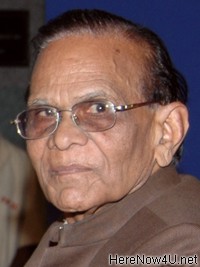According to Jainism every soul in whatever life form or body structure, micro¬organisms, plants, animals or humans, has inherent capabilities to achieve the highest enlightened status of Godhood by its innate efforts (Upadan), availing the opportunities and congenial external environment and assistance. If a particular person intends to progress spiritually, he avails advice of saints, reads such literature, which assists him in his endeavour. These external factors of help are Nimitt. For example a seed of a tree will germinate and develop only if it has capability (good quality) and also if the environment viz. soil, temperature, moisture are suitable. So both the innate capability (Upadan) and external factors (Nimitt) are important. In modern genetics equal weightage (fifty-fifty) is given to innate genetic capability and environment. The innate capabilities differ from person to person and accordingly the opportunities can be availed or ignored. Some are so determined that they even modify and subvert adverse social and physical environment, strive hard and achieve desired success. Such personalities are very few like Thirthankaras. Generally innate capabilities manifest, get modified according to ambient environment. There are examples of human children, somehow strayed in company of wild animals adopting the habits and manners of animals in whose company they are brought up. Very recently a child rescued from the company of monkeys was found to behave walk, eat like monkeys and with difficulty he is being gradually trained into human behaviour.
Paradoxical though it is, the Indian scientists, engineers, doctors etc. work excellently in foreign countries U.S.A., U.K., Canada, and Australia but not here in the country because of the system, environment and opportunities. As a general rule for average innate capabilities, congenial environment is necessary. There are exceptions but they are rare. There are numerous examples of young, though brought up in ideal Jain environment and cultural conditioning, going astray and succumbing to vices of wine, drugs, meat, gambling, prostitution under the changed environment in academic and more so in professional colleges. What could not be imagined just 6-7 decades back that a person born and brought up in a Jain family would ever be prey to vices, is now common and it is now difficult to find a bride groom professional engineer or doctor or senior executive who is free from vices. The reason is simple. The environment particularly in professional educational institutions and then professions also is so ostentatious and consumeristic that even good youngsters fall prey or forced to be by fellow students and colleagues. The trend is growing alarmingly and if not checked by proper corrective measures, there will hardly be any left who will follow even basic minimum fundamental Jain tenets.
Jains are trying for minority status and some states have already recognised it. If it is accorded all over India, then Jains will be able to have their own educational institutions for preserving religious and cultural identity like Muslims and Christians. The clubbing of Jains with Hindu religionists is not correct as Jainism is much different from Vedic, Shaivite and Vaishnavite cults even more than even Islam and Christianity because it does not subscribe to the concept of one Almighty Super Power God, creating, controlling, maintaining and destroying the universe at his own express will. Actually there is no Hindu religion as such. Hindu is word derived from Indu, the term given by Greeks for all those who reside on the side of Indus River. Accordingly all Indians whether Muslims, Christians or Jains are all Hindus. The word Hindu was initially a geographical identity and not a religion. But through passage of time it is now being used in a restricted sense with religious connotation for people except Muslims, Christians. In initial geographical context Jains like all inhabitants of India are Hindus but not in religious sense because Muslims and Christians have been excluded. In the existing circumstances Jains have a strong constitutional claim for minority status.
In order to preserve religious and cultural identity it is necessary to have exclusive Jain educational institutions including vocational and professional (Medical, Engineering, Management and others) where religious education is also imparted and overall environment is maintained according to Jain tenets. It is also necessary to develop industrial, agricultural, trading and other vocational and professional complexes according to Jain traditions so that the Jain students after coming out of Jain educational institutions have not to search out livelihood opportunities elsewhere and remain throughout their life in Jain environment. This alone is only way in the present milieu to preserve Jain identity. Otherwise the youngsters will continue to drift away more and more from Jain tradition. On an experimental basis few such centres may be developed initially at Shri Mahaveerji, Sammed shikharji, Palitana etc.
In view of the importance of the role of external factors, situations and environment, catalytic or real in helping or inhibiting the manifestation of innate strength, capabilities and efforts, it is necessary to understand this aspect in wider and overall perspective. For a Jain who sincerely wants to pursue principles, vows, tenets, injunctions of Jainism, congenial environment is necessary. For example practice of agriculture involves considerable violence and more so in the modern high-tech agriculture. The use of pesticides is deliberate with intention of killing the insect pests. It is outright intentional (Sankalpi). Even if one is not doing cultivation he is using the produce from such intentionally violent practices and is therefore guilty of the violence involved. In Jainism the guilt is three-fold whether one does it, asks or encourages others to do it or even only approves or acquiesces it. It is not like Buddhism where the saints take meat on the pretext that they do not kill and someone else kills. Jainism does not permit such pretexts. However, majority of Jains including saints are at least acquiescing the violence in agriculture. Like Buddhists Jain householders and saints have been inventing pretexts such that they are not doing or that they are helpless. Saints adopt the pretext that they take the meals on the explicit declaration by house-holders that preparations are pure without any violent means. Saints very well know that the constituents of their meals are produced by violent processes and practices. Such false pleas are not acceptable in Jainism yet they are being blatantly approved and adopted.
It is only in forest (Kalpavriksha) based model that Jainism can be practised in letter and spirit. It is not difficult to revive the kalpavrikshas. It is possible with effort and determination. If Jains are sincere about pursuing the tenets of Jainism, they should take the lead and others will follow the perfectly symbiotic model which is free from all sorts of violence, exploitation and harm to anyone. If Jains do not adopt it they are hypocrites like others regarding non-violence and other precepts of the great tirthankaras, renowned saints and scholars.
 S.M. Jain
S.M. Jain
